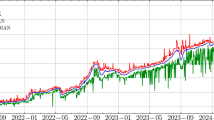Abstract
This paper details first the pricing process of a Bermuda swaption and, in a second step, the pricing of a cross-currency Bermuda swaption from a computational point of view. Our aim is to examine the lengthy process that provides a Bermuda swaption price with special attention to the tests used for assessing the coherence of the price. We only consider long-term derivatives that lead to issues related to missing data and require calibration adjustment. We also deal with the sensitivity of the cross-currency swaption price to the choice of model. The standard model to price this kind of options is a 3-factors hybrid model based on the Libor Market Model that typically combines the domestic market, the foreign market and the foreign exchange market. We study the impact of each one of these stochastic factors on the price of a long-term cross-currency Bermuda swaption. In particular, this study illustrates the relation between the cross-currency product and the volatility of each one of the three markets involved (domestic, foreign and the foreign exchange market).







Similar content being viewed by others
Notes
For more details on the LMM, we refer to Brigo and Mercurio (2006).
References
Ahsan, A. (2003). Multi-factor cross currency Libor Market Models: Implementation. https://doi.org/10.2139/ssrn.1214042.
Andersen, L., & Broadie, M. (2004). Primal–dual simulation algorithm for pricing multidimensional American options. Management Science, 50(9), 1222–1234.
Andersen, L., & Piterbarg, V. (2010). Interest rate modeling. London: Atlantic Financial Press.
Belomestny, D. (2011). Pricing Bermudan options by nonparametric regression: Optimal rates of convergence for lower estimates. Finance and Stochastics, 15(4), 655–683.
Borovykha, A., Pascuccia, A., & Oosterlee, C. W. (2017). Pricing Bermudan options under local Levy models with default. Journal of Mathematical Analysis and Applications, 450(2), 929–953.
Brigo, D., & Mercurio, F. (2006). Interest rate models—Theory and practice. Springer finance. Berlin: Springer.
Dempster, M. A. H., & Hutton, J. P. (1997). Numerical valuation of cross-currency swaps and swaptions. In M. A. H. Dempster & S. Pliska (Eds.), Mathematics of derivative securities (pp. 473–501). Cambridge: Cambridge University Press.
Eberlein, E., & Koval, N. (2006). A cross-currency Lévy market model. Quantitative Finance, 6(6), 465–480.
Guyon, J., & Labordère, P.-H. (2013). Nonlinear option pricing. Boca Raton: Chapman & Hall.
Henrard, M. (2003). Explicit bond option and swaption formula in Heath–Jarrow–Morton one-factor model. International Journal of Theoretical and Applied Finance, 6(1), 57–72.
Henrard, M. (2005). Bermudian swaptions in Hull–White one-factor-model: Analytical and numerical approaches. Working paper Derivatives group, Bank for International Settlements, Basel (Switzerland).
Jensen, M. S., & Svenstrup, M. (2002). Efficient control variates and strategies for Bermudan swaptions in a Libor Market Model. Finance Working Papers 02-23, University of Aarhus, Aarhus School of Business, Department of Business Studies.
Labordère, P.-H. (2007). Combining the SABR and LMM models. Risk: Managing Risk in the World’s Financial Markets, 20(10), 102–107. London : Incisive Financial Publ.
Longstaff, F. A., & Schwartz, E. S. (2001). Valuing American options by simulation: A simple least-squares approach. Review of Financial Studies, 14(1), 113–147.
Mercurio, F., & Morini, M. (2009). Joining the SABR and Libor models together. Risk, 22(3), 80–85.
Rogers, L. C. G. (2010). Dual valuation and hedging of Bermudan options. SIAM Journal on Financial Mathematics, 1, 604–608.
Schweizer, M. (2002). On Bermudan options. In K. Sandmann & P. J. Schonbucher (Eds.), Advances in finance and stochastics. Essays in an honour of Dieter Sondermann (pp. 265–269). Berlin: Springer.
Wang, M.-C., & Huang, L.-J. (2018). Pricing cross-currency interest rate swaps under the Levy market model. To appear in review of derivatives research. https://doi.org/10.1007/s11147-018-9150-1.
Zhang, B., & Oosterlee, C. W. (2012). Fourier cosine expansions and put-call relations for Bermudan options. In Numerical Methods in Finance: Springer Proc. Math. (vol. 12, pp. 323–350). Heidelberg: Springer.
Author information
Authors and Affiliations
Corresponding author
Additional information
Publisher's Note
Springer Nature remains neutral with regard to jurisdictional claims in published maps and institutional affiliations.
Appendices
Appendices






Rights and permissions
About this article
Cite this article
Erkan, B., Prigent, JL. About Long-Term Cross-Currency Bermuda Swaption Pricing. Comput Econ 56, 239–262 (2020). https://doi.org/10.1007/s10614-019-09899-7
Accepted:
Published:
Issue Date:
DOI: https://doi.org/10.1007/s10614-019-09899-7




